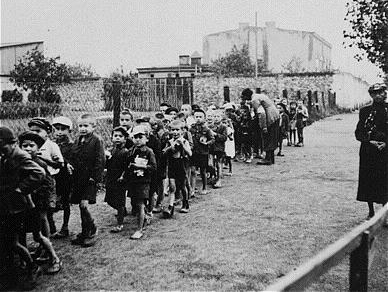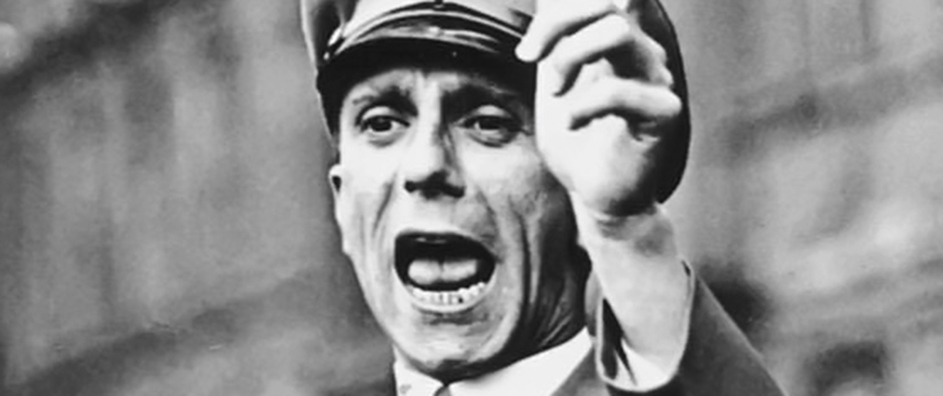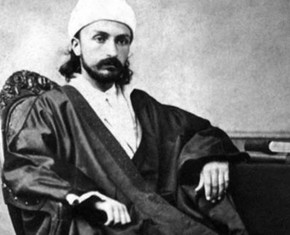The views expressed in our content reflect individual perspectives and do not represent the authoritative views of the Baha'i Faith.
In the middle of World War II, as the Nazis began to lose critical battles in Europe, Hitler and Himmler ramped up their efforts to exterminate the people they called “Untermensch” – sub-human.
Beyond the concentration and forced labor camps, they accelerated the activity at the “Todeslager” – the death camps – whose mission was the wholesale, industrial extermination of everyone the Nazi regime considered sub-human.
These genocidal camps have no equals when it comes to horror. Some historians estimate that approximately six million people were killed in the death camps. But other estimates range as high as 15-20 million deaths in total. No one will ever know the exact toll in human souls.

Children being taken to Chelmno Extermination Camp
Human beings have a very difficult time understanding numbers like those, or even beginning to comprehend such savagery. Every subsequent artist, writer, scholar, historian, filmmaker and chronicler of the Holocaust (or the Shoah, as it’s known to many) has faced the immensity of such incomprehensible, inhumane evil — and wondered how it might be even remotely possible to depict it.
One story, from the Hungarian journalist and author Renee Szanto-Felbermann in her memoir Rebirth, captures the human scale of this monstrous tragedy by telling the tale of two unlikely friends:
The first new Baha’i who found his way to us after the end of the war was a young medical student…
During the war, as a boy of eighteen, he had to work in a forced labor battalion because of his Jewish origin, and was deported to Weimar Neustadt, Austria…. There he met a Baha’i from Poland, a highly cultured man, who told him of Baha’u’llah and the Baha’i Faith and gave him the moral strength to endure the terrible hardships to which they were all subjected. Finally, they did not get anything to eat. They were just left to starve, having been selected to be taken to the gas chambers at Auschwitz. The boy was so weak that he thought he would die. The Baha’i from Poland still possessed one carrot he had uprooted from a field and kept as a last reserve. This carrot he handed to his young friend, saying “I am much older than you and have lived my life, yours is still before you, take this carrot, perhaps it will save your life, and remember Baha’u’llah.” The carrot gave the boy the strength to go out and search for water, when he suddenly found himself face to face with an acquaintance from Hungary of German descent, now a soldier and wearing a German uniform. “What are you doing here?” the other asked, very much surprised. Hearing his story, he said: “Come quickly, I can save you, I am here with a lorry and am on the point of returning to Budapest, I shall hide you in the lorry and take you back.”
Thus he escaped.
The Polish Baha’i, together with the other members of the forced labor battalion, was taken to Auschwitz where they all perished. – Rebirth, p. 160.
The Nazi atrocities convinced millions of people that God was dead. If a loving God existed, their reasoning went, how could such unprecedented suffering and death, especially at the hands of supposedly civilized people, be allowed to occur?
The Baha’i teachings face this seminal question directly. Baha’is believe that a kind and loving Creator abhors human suffering; but grants us free will so we can determine our own destinies. Baha’is believe that humanity itself has the responsibility to bring such rampant evil to a halt. Baha’is also believe that we human beings exist at the pivotal point of the spiritual and the physical – that we will, if we focus on our inner lives and our spiritual reality, rise to the heights of what humans can accomplish and become; but that if we ignore our souls and allow hatred to rule our hearts and minds, we will sink into the depths of depravity, lower than the most vicious animal:
In man there are two natures; his spiritual or higher nature and his material or lower nature. In one he approaches God, in the other he lives for the world alone. Signs of both these natures are to be found in men. In his material aspect he expresses untruth, cruelty and injustice; all these are the outcome of his lower nature. The attributes of his Divine nature are shown forth in love, mercy, kindness, truth and justice, one and all being expressions of his higher nature. Every good habit, every noble quality belongs to man’s spiritual nature, whereas all his imperfections and sinful actions are born of his material nature. – Abdu’l-Baha, Paris Talks, p. 60.
The Nazis were defeated by an enormous global effort in World War II – but the racial supremacy their ideology exalts still exists in the lower natures of many people. The Baha’i teachings present a plan to humanity that calls for the elimination of those prejudices and hatreds.

















Comments
Sign in or create an account
Continue with Googleor